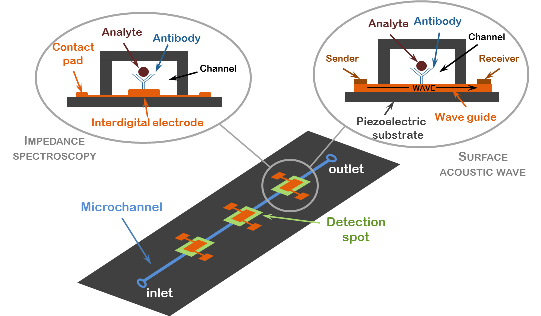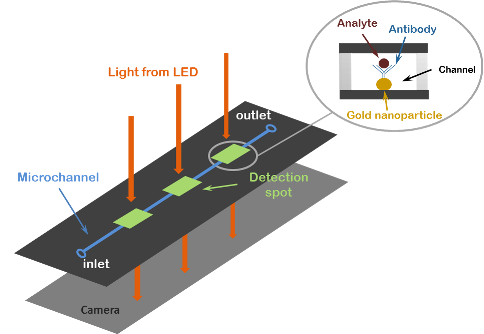Biotechnology
Immunological detection
MicroBioMed project focuses on the immunological detection of analytes on a chip in the frame of in vitro diagnosis. In other words, a specific antibody will recognize and bind the target antigen within a biological sample.
From immunoassay in the lab…
Immunoassays, which make use of this antibody – antigen recognition, are commonly performed within research or analytical laboratories for a variety of applications: medical diagnosis, pharmaceutical analysis, environmental and food safety testing, as well as basic scientific investigations.
Different techniques are used: ELISA using enzymes as labels, radioimmunoassay (RAI), immunoquantitative PCR…
All these techniques are well-known, efficient and reliable. Nevertheless they require laboratory equipment as well as specialized workforce, which makes them costly and time consuming.
…to immunoassay on a chip
Development of lab-on-a-chips has made it possible to miniaturize, integrate and automate many tests usually performed in the laboratory onto one single chip.
For lab-on-a-chip detection, immunoassays also rely on the antibody – antigen recognition but don’t make use of labels such as enzymes or DNA. In fact changes in optical properties or in resistance on an electrode will be detected.
In MicroBioMed, different techniques are being studied.
Electrical detection
- Impedance spectroscopy: interdigital electrodes are integrated in the microfluidic channels and functionalized with antibody receptors. By applying alternative current to the electrodes, the electrical signals change with respect to the immobilization of receptor on the electrode area.
- Surface acoustic waves: acoustic waves propagate through a piezoelectric substrate. The travel time of the wave from the sender to the receiver electrode depends on the mass which is attached to the substrate’s surface. The binding of an analyte results in slower wave propagation.

Optical detection - Local Surface Plasmon Resonance
Plasmonic gold nanoparticles are functionalized with antibody receptors, which can detect target analytes, and are immobilized onto the surface. Once the bio-reaction takes place, the gold nanoparticles will change their optical properties due to the local refractive index change, resulting in a wavelength shift in light absorption.

